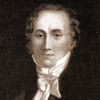
Frederick Maning 1812-83 |
|
|
My dear brother, I have made up five cases of plants containing new things that was worth sending one container variegated flax (the small long narrow one marked with a cross cut on both ends) the finest flower in this country called kowai ngata kaka or Cockatoo beak flower it grows straggling like a vine and i think should be trained over something it will show at perfection over a considerable space and is entirely covered with large handsome flowers. I send a good many young plants with roots and some cuttings i think it is sure to grow. there is also a plant of a species of the Kawa which grows to a very handsome shrub that you will know by its leaves of a heart like shape there is also a number of young plants of a tree called Nikau or neecow it is a sort of cabbage palm i think and is very handsome any New Zealander will describe to you the other things and tell you their names. I have not got them on board yet there is a strong fair wind blowing and this is the day the Oudora ??? was to sail .......... Letter to Archibald Maning 21 August 1844 My dear brother, I send by the Nimrod 200 flax plants the freight is paid in consequence of the trip having been detained longer than was expected. They have been out of the ground..... should have been but I think they should live up it, would have been impossible to send a great number in this ship as there is no room and they would take up a great space if packed in cases with earth but by this experiment we can see if live up without packing in mould which would be a great thing to know the best time for flax them is approaching................................ the plants are one of the kind not found wild but cultivated by the natives........... Letter 15 March 1845 Pakeha Maori opposition to British rule was particularly vocal when Hobson met with the Hokianga chiefs. Among the more notable Pakeha Maori opponents of European law and order was Frederick Maning who had settled in the district to escape ‘the straps and strings of civilisation’. His opposition, like that of Jacky Marmon, was founded on materialism, not idealism. By 1840, Maning was prospering in the kauri timber trade and feared the imposition of regulations. Maning’s lifestyle and his atheism alienated him from the missionaries and more respectable settlers but he was content to remain outside European society. His book Old New Zealand laments the passing of the freedom of action enjoyed by the Pakeha Maori. ‘But those were the times!-“the good old times” before Governors were invested, and law and justice and all that. When everyone did as he liked except when his neighbours would not let him, (the more shame for them)-when there were no taxes or duties, or public works, or public to require them.”’ During the Treaty debates attended by more than 2000 Maori and sixty chiefs, Maning translated for the chiefs and vociferously opposed their signing the document. He bluntly told Hobson that he had advised the Maori to resist British overtures because he thought that European colonisation would degrade them. Maning also considered it inadvisable to apply British law to Maori. Hobson believed, incorrectly, that Maori opposition at the Hokianga was traceable to the influence of the Catholic Bishop Pompallier. Hobson said of Maning, ‘He is the active agent of the Bishop.” Hobson was closer to the truth in his assumption that Maori opposition was also traceable to the influence ‘of a set of escaped convicts and other low ruffians who have congregated on this river in considerable numbers.’ Trevor Bentley Pakeha Maori: the extraordinary story of the Europeans who lives as Maori in early New Zealand Auckland: Penguin, 1999, pp. 132-33
|
